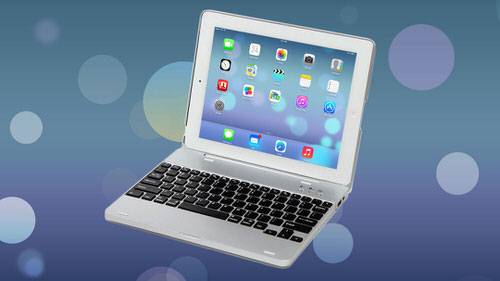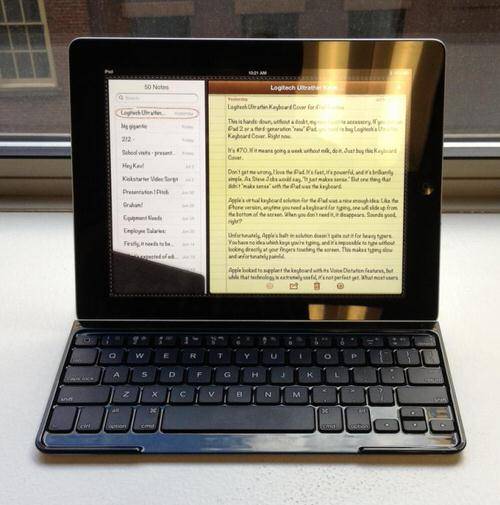On Friday, January 24, the Mac will turn 30. The personal computer is clearly an important part of Apple’s past. But what role does it play in Apple’s future?
The key may be OS X, the 14-year-old operating system still running Macs today.
When Apple unveiled the iPhone in 2007, it pulled off a neat trick, cramming a version of OS X down into a tiny touchscreen smartphone. That feat sent rivals at Research In Motion and Google scrambling to figure out how Apple had done it. Eventually, that stripped-down version of OS X became known as iOS, which powers iPhones and iPads.
But even though OS X and iOS share technical roots, Apple has for the most part developed them separately. An iPhone app won’t run on a Mac, and Mac software won’t run on an iPhone or iPad.
What if that changed?
Developers and other experts ReadWrite has spoken to are intrigued by the notion of a hybrid device that offers the best of the company’s desktop and mobile experiences. Many believe this device will be a large iPad with a built-in keyboard cover aimed at professionals—an “iPad Pro,” if you will—that can handle applications built for both iOS and OS X, and switch between touchscreen and keyboard input.

Why Now’s The Time For Apple To Merge Its Operating Systems
An iPad Pro would just be the beginning, though, of a long-term strategy to bring its operating systems together. There are a number of reasons, technical, organizational, and financial, for Apple to do so.
- In 2012, Apple CEO Tim Cook ousted Scott Forstall, who previously kept a tight grip over iOS software development. Now, one executive, Craig Federighi, oversees both iOS and OS X.
- Apple’s latest mobile devices, the iPhone 5S and iPad Air, share a powerful 64-bit processor—on a similar scale of power to the chips now found in desktop computers.
- After years of rising alongside iPhone and iPad sales, Apple’s Mac unit sales dropped in 2013. Cook has often spoken of how Apple would rather cannibalize Mac sales by selling iPads than let someone else cannibalize the Mac; that now seems to be happening.
Canonical founder Mark Shuttlesworth believes Apple’s OS convergence is inevitable.
“Mobile processors are catching up with the desktop,” Shuttlesworth recently told PCPro. “When Apple announced the iPhone 5S, it called the processor ‘desktop-class’, and I don’t think that was an accident—it was sending what we think is a very clear signal that it will converge the iPhone and the MacBook Air.”
But mobile applications, even Apple’s, aren’t yet as capable as their desktop counterparts. Merging iOS and OS X could be a risky move, as it could potentially alienate core desktop users, but it could also be Apple’s way of, as Wayne Gretzky put it, “skating to where the puck is going to be, not where it’s been.”
How Would An iOS/OS X Product Work?
Apple never designs in a vacuum; everything is integrated, especially hardware and software. Merging iOS and OS X into a single product would need to serve a purpose for a new kind of device.
There are two basic ways Apple could make a “hybrid” operating system.
- Apple literally merges its two operating systems, which would force Apple engineers and iOS and Mac developers to completely rewrite their software for a multitouch-friendly version of OS X.
- Apple builds a product that can dynamically switch between iOS and OS X with the tap of an icon.
The second option—building a product that switches between operating systems—may be Apple’s most feasible strategy for the moment. Eventually, iOS and OS X may become so similar that OS X is eventually folded into iOS, but that doesn’t seem likely in the short term.
In the case of an “iPad Pro,” offering both iOS and OS X makes a great deal of sense as a professional-leaning iOS product.
As it currently stands, the iPad is extremely close to being a capable laptop replacement. However, the iPad still lacks a few key PC features, like ports for a wider variety of peripherals, a physical built-in keyboard, and a true file management system to manipulate and move files on and off the iPad. And even when you attach a keyboard, the touch-centric interface makes some tasks slower and clunkier than they’d be on a desktop.
An iPad/MacBook combination, however, that could switch from iOS in “tablet mode” to OS X in “laptop mode,” could strike a balance as a substantial computer for both work and play.
See more: Mysteries Of Apple’s iOS 7 … Revealed!
It’s not enough, though, for Apple to make a device that appeals to the information workers who currently buy its MacBook line.
Apple must also court another audience for such a move to make sense: developers.
Rich Siegel is the cofounder of Cleaversoft, the company behind popular iOS games like Beard Wars and Puppy Wars. As a developer, he says he’d look for “complete backwards compatibility” so all iOS and OS X apps would work on the device. Such a move, he believes would be “great for customers and developers.”
“It’ll be bit of a pain as a developer because now all apps will have to have a touch mode and desktop mode, but I think over time that’s where things are heading,” Siegel told ReadWrite. “Imagine a future where you walk around with the power of a Mac Pro in your pocket and stations are everywhere for you to use it like a desktop computer.”
Siegel said a single platform offering both operating systems would benefit developers financially because desktop applications tend to cost more, so a bundled iOS-OS X application would likely cost more than just 99 cents.
“Whenever this hybrid system comes out, it’ll be another gold rush for developers, similar to when iOS first opened up, or when iPad came out,” Siegel said. “One day universal apps won’t just mean ‘iPhone or iPad,” it’ll mean desktop/iPhone/iPad/iTV/iWatch. That’s what consumers will expect. While some developers will fall by the wayside, those innovating with great cross platform solutions will do very well.”
Apple has already laid some groundwork. For example, iOS developers use Cocoa Touch, a framework which Apple says “share[s] many patterns” with Cocoa, its framework for OS X development. A hybrid app-development system would simply need to support both those frameworks simultaneously, when they already overlap in many fundamental aspects.
Why Would Consumers Want Two Operating Systems In One?

For about a year, I tried using my third-generation iPad as my main travel computer. The iPad could do most things a PC could do, but it fell short in a few key ways. I wished I could download and open more types of files from the Web—only PDFs and images routinely worked—or use my favorite Adobe applications. The iPad also doesn’t allow browser extensions, which can boost productivity on a desktop.
On one occasion, my iPad’s note-taking app didn’t save to iCloud properly. Instead of giving me a corrupted file I could examine or extract, the file was gone, and there was nothing I could do to get my work back. On another occasion, my iPad screen broke and I needed to replace the entire device; many apps could be backed up to iTunes, but not all of them, and I lost all of the work I’d created on my illustration apps.
For consumers, an iPad Pro would appeal to those who need a PC for work but want an iPad for activities like illustrating or reading. Microsoft technically got to the tablet-laptop first with the Surface, but Apple specializes in taking existing products and perfecting their designs until they feel like new innovations. An easy-to-use iPad-MacBook hybrid would be a hit with creative professionals who want a trustworthy computer with the ability to snap off the screen and use it as a fully-functional tablet.
Weaving iOS and OS X into a single product won’t be easy. Though Apple has said its iOS and OS X teams are collaborating now more than ever, optimizing the architecture for both iOS and OS X will require a lot of power, which could result in a lot of trade-offs, especially when it comes to battery life.
But there’s no denying the many potential upsides to an enterprise-centric iPad: Besides what it would offer consumers—an iPad or MacBook when you want it—Apple would enjoy large profit margins off the device, since an iPad geared towards professionals would not be cheap. (An iPad Pro would likely cost around $700-$900, filling a gap in Apple’s price spectrum between a high-end iPad and the cheapest MacBook.)
A Kitchen Appliance Or A Hot New Vehicle?
Apple CEO Tim Cook previously scoffed at the idea of convergence, comparing it to a “toaster-refrigerator”, but Apple has practiced misdirection before. Let’s consider another analogy Apple cofounder Steve Jobs offered a different analogy in 2010: PCs are going to be like trucks.
He was right, of course, in pointing out that most people have cars, not trucks. But the Mercedes-loving Jobs may have missed the diversity of today’s automobile market, where it’s not a straight choice between a car or a truck. Crossover vehicles are increasingly popular. Crossovers, of course, are SUV-like vehicles built on the same platform as a car.
Kind of like a hybrid mobile-desktop device.
It’s pretty clear what road Apple is driving down today.
Lead and top right photoillustrations by Madeleine Weiss for ReadWrite; lower right image by Dave Smith for ReadWrite




















